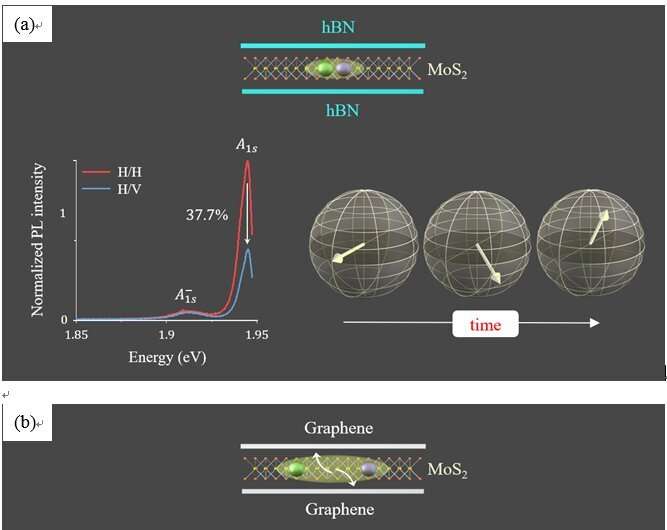This article has been reviewed according to Science X's editorial process and policies. Editors have highlighted the following attributes while ensuring the content's credibility:
fact-checked
peer-reviewed publication
trusted source
proofread
Study finds a solution to longstanding problem of ultrafast valley decoherence

Since the realization that a linearly polarized light can create K-K' valley coherent excitons in monolayer transition metal dichalcogenide (TMDC) semiconductors back in 2013, it has been a longstanding goal for researchers to use these excitonic states for coherent manipulation and qubit operation.
Unfortunately, to the disappointment of many, it was also quickly revealed that such a valley coherence rapidly degrades in a timescale of 100 fs—thus, any such coherent manipulation becomes almost impossible. In addition, the radiative lifetime being about 10-fold larger, the exciton experiences strong valley decoherence before its radiative recombination, and thus the optical readout of valley coherence is challenging as well. The primary culprit that forces such ultrafast valley decoherence is a combined effect of scattering and inter-valley exchange interaction.
In a new paper published in Light: Science & Applications, a team of scientists, led by Professor Kausik Majumdar from the Quantum Electronics Laboratory at the Department of Electrical Communication Engineering, Indian Institute of Science, Bangalore, India, and co-workers have found a solution to this longstanding problem by encapsulating MoS2 with a top and a bottom layer of graphene.
This structure provides ~100% degree of linear polarization (DOLP) in steady state photoluminescence (PL) measurement—a direct evidence of valley coherence time being larger than exciton lifetime (estimated to be ~2–3 ps in these samples). This also indicates that they achieved a valley coherence time which is at least 10-fold longer than previous reports.
Using a clever design of experiments of four different stacking of layers and subsequent data analysis supported by solutions of the Bethe-Salpeter equation and the Maialle-Silva-Sham (MSS) equation, the authors prescribe a systematic way to improve valley coherence:
- Enhancing dielectric screening helps to reduce exchange interaction, and thus improves valley coherence.
- However, a drawback of enhanced screening is enhanced lifetime, which allows for more random phase accumulation, and thus degrades valley coherence.
- Combining enhanced screening with a fast-filtering mechanism (for example, through exciton transfer to graphene) that filters out long-lived excitons eradicates the problem stated in point 2 above, providing ~100% DOLP.
"Interestingly, as an added advantage of fast charge transfer to graphene in the same GMG stack, the excitonic peaks are found to be very clean, and of narrow linewidth, with no spurious peaks from trion and other excitonic complexes," they added.
The scientists conclude, "The enablement of the optical readout of such perfect valley coherence through achieving longer-than-lifetime valley coherence time of excitons in monolayer semiconductors can have far reaching implications in new experiments as well as in possible applications such as quantum information processing."
More information: Garima Gupta et al, Observation of ~100% valley-coherent excitons in monolayer MoS2 through giant enhancement of valley coherence time, Light: Science & Applications (2023). DOI: 10.1038/s41377-023-01220-4
Journal information: Light: Science & Applications
Provided by Chinese Academy of Sciences




















